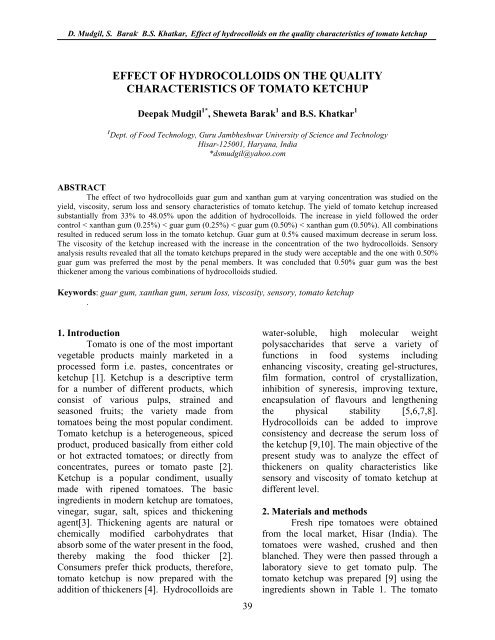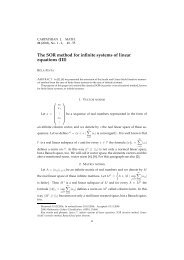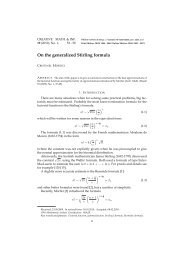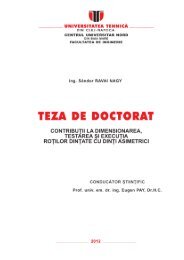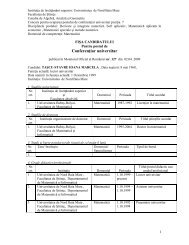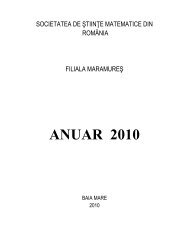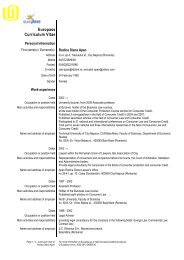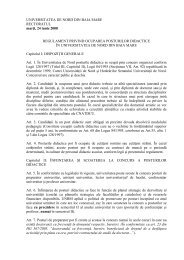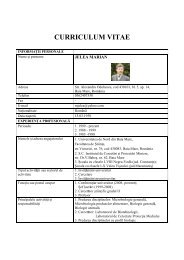Vol 3 (1) 2011 - UBM :: Departamentul de Chimie-Biologie
Vol 3 (1) 2011 - UBM :: Departamentul de Chimie-Biologie
Vol 3 (1) 2011 - UBM :: Departamentul de Chimie-Biologie
You also want an ePaper? Increase the reach of your titles
YUMPU automatically turns print PDFs into web optimized ePapers that Google loves.
D. Mudgil, S. Barak , B.S. Khatkar, Effect of hydrocolloids on the quality characteristics of tomato ketchup<br />
EFFECT OF HYDROCOLLOIDS ON THE QUALITY<br />
CHARACTERISTICS OF TOMATO KETCHUP<br />
Deepak Mudgil 1* , Sheweta Barak 1 and B.S. Khatkar 1<br />
1 Dept. of Food Technology, Guru Jambheshwar University of Science and Technology<br />
Hisar-125001, Haryana, India<br />
*dsmudgil@yahoo.com<br />
ABSTRACT<br />
The effect of two hydrocolloids guar gum and xanthan gum at varying concentration was studied on the<br />
yield, viscosity, serum loss and sensory characteristics of tomato ketchup. The yield of tomato ketchup increased<br />
substantially from 33% to 48.05% upon the addition of hydrocolloids. The increase in yield followed the or<strong>de</strong>r<br />
control < xanthan gum (0.25%) < guar gum (0.25%) < guar gum (0.50%) < xanthan gum (0.50%). All combinations<br />
resulted in reduced serum loss in the tomato ketchup. Guar gum at 0.5% caused maximum <strong>de</strong>crease in serum loss.<br />
The viscosity of the ketchup increased with the increase in the concentration of the two hydrocolloids. Sensory<br />
analysis results revealed that all the tomato ketchups prepared in the study were acceptable and the one with 0.50%<br />
guar gum was preferred the most by the penal members. It was conclu<strong>de</strong>d that 0.50% guar gum was the best<br />
thickener among the various combinations of hydrocolloids studied.<br />
Keywords: guar gum, xanthan gum, serum loss, viscosity, sensory, tomato ketchup<br />
.<br />
1. Introduction<br />
Tomato is one of the most important<br />
vegetable products mainly marketed in a<br />
processed form i.e. pastes, concentrates or<br />
ketchup [1]. Ketchup is a <strong>de</strong>scriptive term<br />
for a number of different products, which<br />
consist of various pulps, strained and<br />
seasoned fruits; the variety ma<strong>de</strong> from<br />
tomatoes being the most popular condiment.<br />
Tomato ketchup is a heterogeneous, spiced<br />
product, produced basically from either cold<br />
or hot extracted tomatoes; or directly from<br />
concentrates, purees or tomato paste [2].<br />
Ketchup is a popular condiment, usually<br />
ma<strong>de</strong> with ripened tomatoes. The basic<br />
ingredients in mo<strong>de</strong>rn ketchup are tomatoes,<br />
vinegar, sugar, salt, spices and thickening<br />
agent[3]. Thickening agents are natural or<br />
chemically modified carbohydrates that<br />
absorb some of the water present in the food,<br />
thereby making the food thicker [2].<br />
Consumers prefer thick products, therefore,<br />
tomato ketchup is now prepared with the<br />
addition of thickeners [4]. Hydrocolloids are<br />
39<br />
water-soluble, high molecular weight<br />
polysacchari<strong>de</strong>s that serve a variety of<br />
functions in food systems including<br />
enhancing viscosity, creating gel-structures,<br />
film formation, control of crystallization,<br />
inhibition of syneresis, improving texture,<br />
encapsulation of flavours and lengthening<br />
the physical stability [5,6,7,8].<br />
Hydrocolloids can be ad<strong>de</strong>d to improve<br />
consistency and <strong>de</strong>crease the serum loss of<br />
the ketchup [9,10]. The main objective of the<br />
present study was to analyze the effect of<br />
thickeners on quality characteristics like<br />
sensory and viscosity of tomato ketchup at<br />
different level.<br />
2. Materials and methods<br />
Fresh ripe tomatoes were obtained<br />
from the local market, Hisar (India). The<br />
tomatoes were washed, crushed and then<br />
blanched. They were then passed through a<br />
laboratory sieve to get tomato pulp. The<br />
tomato ketchup was prepared [9] using the<br />
ingredients shown in Table 1. The tomato


